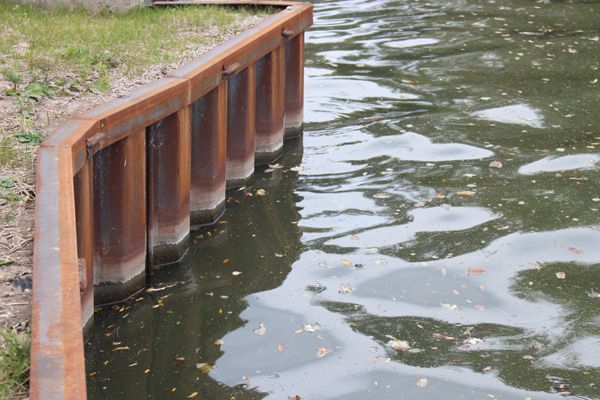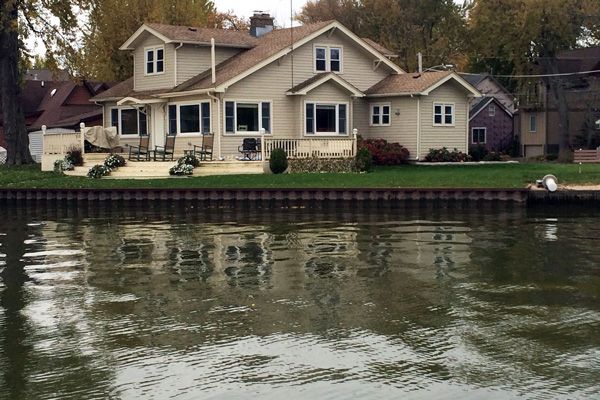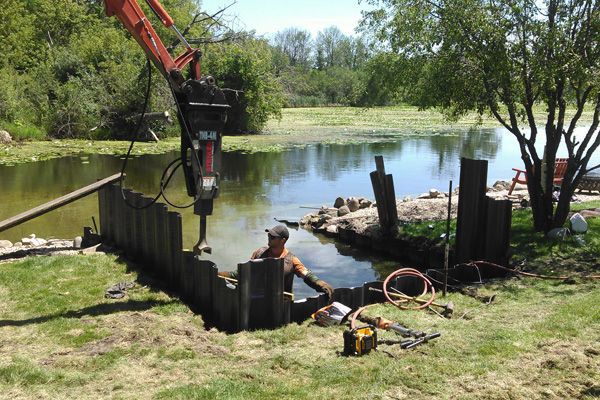Here’s everything you need to know about steel seawalls—all in one place!
A sea wall is a type of coastal defense installed along a shoreline. Its purpose is to protect areas of human habitation and conservation against erosion and other damage caused by water. They are made from many different materials, but among the most popular are steel, timber, vinyl, and aluminum. In this guide, we focus only on steel seawalls, how they are built, along with their benefits, and maintenance requirements.
Learn More About Our Steel Seawall Service
How are steel seawalls installed?
The process begins by excavating the shoreline to make room for the construction of our steel structure. Steel seawalls come in 8,7, and 5-gauge thickness as well as galvanized. They are driven into the lake or riverbed to the depths equaling the height of the wall. So, if the wall is five feet high, then the steel sheet will embed five feet into the ground. This step ensures the most stability possible.
A concrete and steel piling “dead man” system acts as an anchor. A Dead man is a term that refers to a large, underground weight meant to keep a wall from pulling away from a hill. Or, in this case, to keep the seawall from separating from the shoreline.
Once the dead man is firmly in place, the construction crew fills the surrounding area. While some contractors might fill with soil, it’s often better to fill with medium-sized #8 stone. Reason being, soil soaks up and retains water from rain and what it absorbs through the water way. All this excess water can cause undue wear and tear on your seawall. On the other hand, stone allows water to pass straight through it.
Once the space is filled, it’s covered with a vented plastic sheet, top soil, a straw blanket, and grass seed. The plastic sheet prevents the soil from falling through the stone, while the grass regrows over the top.
Why choose steel?

While the most common material used in seawall construct, steel comes with a hefty price tag. But they’re widely considered to be the strongest and require the least maintenance. In fact, steel’s durability and resilience to the elements make it an industry-favorite. This makes the initial cost well-worth the investment.
Steel seawalls install easily into any substrate. Additionally, they have no height limitations for its design, unlike other types of materials. Also, they offer the same benefits that all seawalls do, such as:
Protecting your land against erosion
The natural ebb and flow of the water’s tides slowly break up the land, causing disintegration. Over a long period of time, the water moves steadily inward. Which can wreak havoc on homes and businesses built close to the water. Seawalls help preserve the shoreline and keep the water at bay. Steel is an especially attractive choice because of its versatility and ease of installation.
Preventing excessive flooding.
When you live by the shore, flooding is a constant risk. But you can significantly control the damage with seawalls. We can use historical rainfall records to guess at how high to build your seawall to protect against flooding. Naturally, storms are unpredictable. So, it’s impossible to know exactly how high water will rise in any given circumstance. But with a well-designed seawall in place, your property has significant protection from flooding.
Saving space and money.
Believe it or not, seawalls take up much less space and are cheaper than other coastal defenses, like dikes. Their spatial economy benefits landowners because of the higher value often placed on waterfront properties. Less space designated to seawalls, results in less land compromised for construction. Furthermore, seawalls have a good longevity, so that your seawall seldom needs replacing.
The downside of using steel is that, without proper maintenance, it eventually rusts. Also, if not carefully monitored, sharp shards can develop that pose a safety hazard to swimmers. But luckily, these dangers are avoidable by practicing good maintenance.

What maintenance do steel seawalls require?
Whether residential or commercial, the questions surrounding seawall maintenance are the often the same. Typically, seawalls are easy to care for, requiring little maintenance. At the very least, seawalls need a visual inspection a few times per year—especially after major storms. When conducting these inspections, watch out for things like cracks, splinters, or unusual movements. These might indicate a larger problem with your seawall that needs professional intervention.
Protecting against ice damage.
Hands down, one of the biggest dangers facing seawalls in the Midwest is the temperature fluxes experienced during winter. Ice that melts and refreezes results in a cycle of expansion and contraction. This can cause cracks in your seawall to worsen. Likewise, during the spring, large chunks of melting ice can scrape against your seawall, resulting in quicker deterioration.
Slowing disintegration over time.
Another major factor working against your seawall is time. While steel seawalls protect against erosion, they can’t halt the process entirely. Sooner or later, the natural wear and tear caused by the elements disrupts your seawall’s stability.
But there are ways to keep the corrosion at bay. Primarily, steel seawalls benefit from a periodic coating of protectant to fight against rust. Additionally, we recommend servicing your steel seawall at least once every five years. High-quality care for your seawall is of the utmost importance if you want to get the most out of it. If properly maintained, healthy steel seawalls should last a good 25 years.
Steel seawalls are a reliable choice for shoreline protection.
If you live on a lake, river, or other body of water, steel seawalls are a reliable choice for protecting your shoreline. They are durable, resilient, and offer an attractive transition from landmass to water. But for best results, hiring a quality crew to handle your installation is key. The top-notch staff at Seawalls Unlimited is happy to assess your property and provide quotes for steel seawall installations. We’ll support you every step of the way to ensure your shoreline has the best possible protection against erosion.

